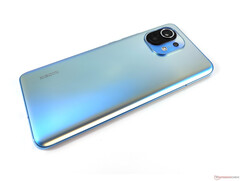Our review of the Xiaomi Mi 11 also confirms the reports that had already emerged at the beginning of the year concerning strong heat development in the Qualcomm Snapdragon 888. The latest high-end chipset from Qualcomm that is installed in the Mi 11 is based on the new Kryo 680 CPU unit. This integrates a fast "Prime Core" based on the Arm Cortex-X1 architecture with speeds of up to 2.84 GHz, three fast Cortex-A78-based performance cores (2.42 GHz), and four Arm Cortex-A55 cores with a maximum clock rate of 1.8 GHz. Besides the CPU unit, the chipset has a Qualcomm Adreno 660 as graphics processor.
In our benchmark package, the Xiaomi Mi 11's Snapdragon 888 shows its strength - but only in a well-cooled state. During prolonged load, the Xiaomi phone displays an overheating protection alert, and the benchmarks are aborted. But even without crashes due to overheating, evaluating performance is quite difficult because the results of one same benchmark show large variations. Only when the EU model with the global software reaches us will we be able to say if only the Chinese version, which was provided to us for testing, is affected by this high heat development. According to reports, however, the global ROM of the Mi 11 seems to be more balanced.
The Xiaomi Mi 11 leaves an excellent impression in everyday use because the thermal problems are hardly noticeable here. Under "normal" load, such as a 30-minute gaming session or recording several 8K videos in a row, heat development is clearly noticeable, but we don't detect any performance losses. The Mi 11's consistency is also very decent in the Wild Life stability stress test.
The rear-facing glass case of the Xiaomi Mi 11 heats up relatively noticeably under continuous load. However, the flagship smartphone only gets properly hot in benchmark programs that stress both the CPU and the GPU. This overheating is probably due to poor processor management. It's also possible that the Adreno 660 GPU with its high clock rate plays a significant role here, since it has been increased from 587 MHz to 840 MHz compared to the Adreno 650 in the Snapdragon 865.
Are you interested in the "affordable" flagship smartphone from Xiaomi? If so, you can get a detailed impression of the Mi 11 in our detailed review of the Mi smartphone.
Source(s)
Review of the Xiaomi Mi 11


















